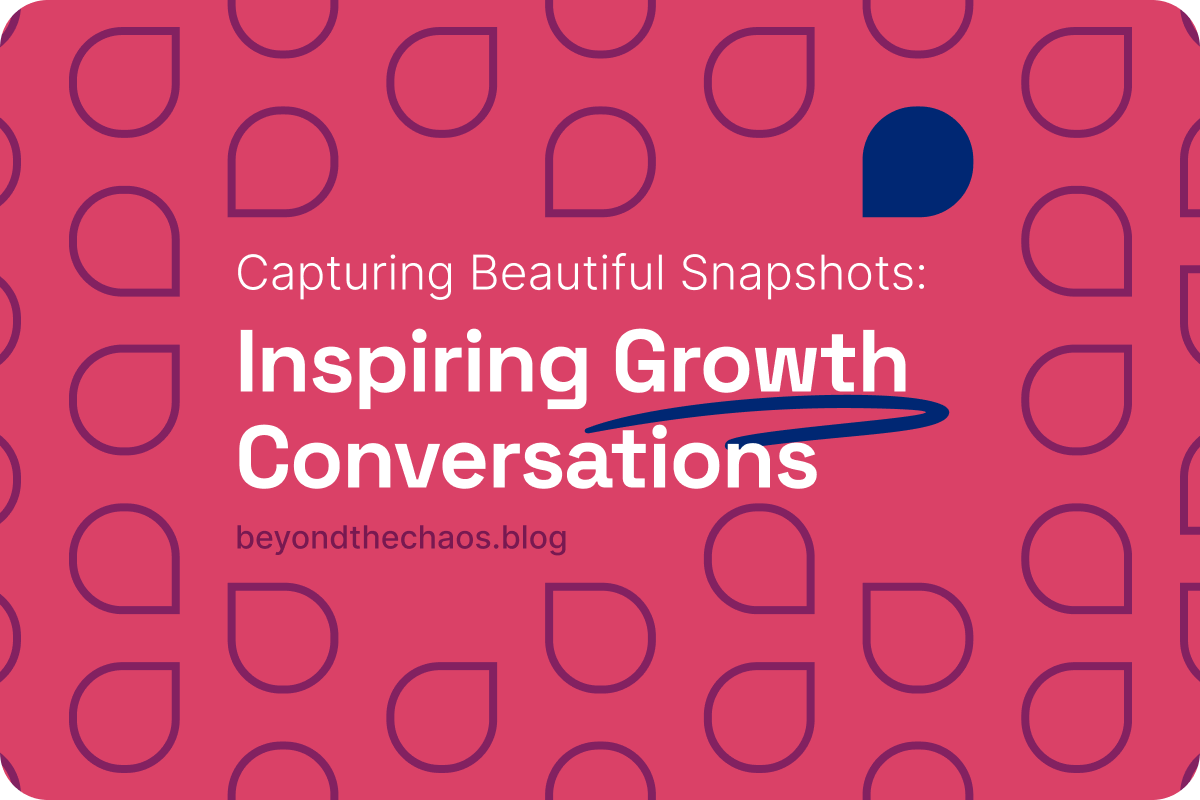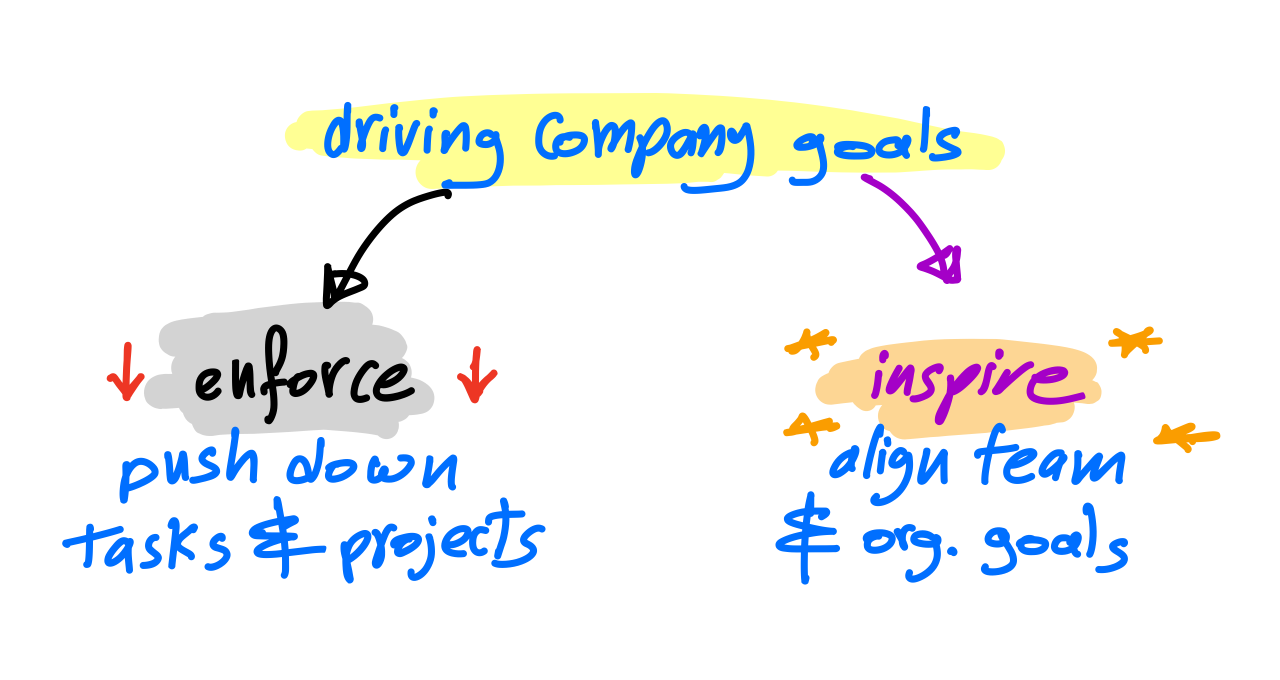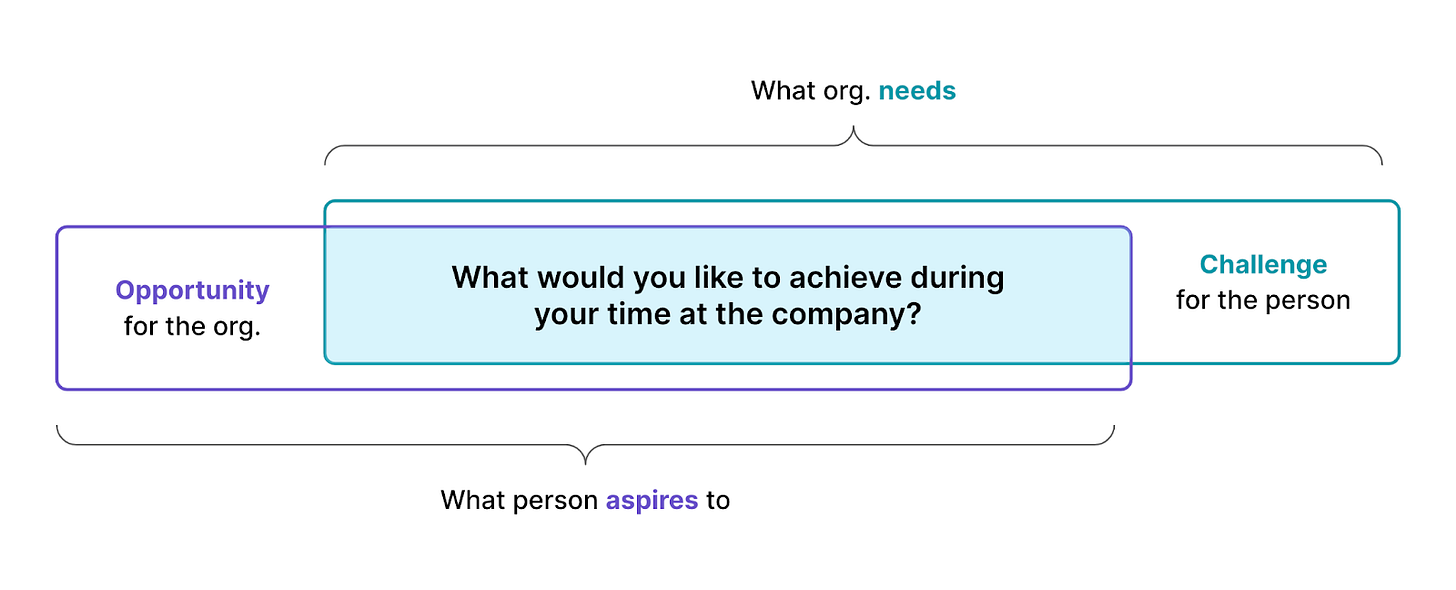Capturing Beautiful Snapshots: Inspiring Growth Conversations
This is one of my favorite photos that I have taken ever since I learned photography. I took it in Japan.
My main subject is blurry (actually the whole photo is so out of focus), the light is unbalanced, and … it’s just technically not great. However, I just love it. It reminds me of a great place and a great memory. I take one look at it and I immediately smell the air from there. It brings so many feelings and thoughts to my brain and it makes me almost travel back there.
I couldn’t find a better personal update to begin this article. Reflecting on my career growth, I look back at moments just like this photo … imperfect but genuine. And I’m eternally grateful for everyone who helped me capture them.
Backstory
So … let’s talk about performance reviews… such loaded and crucial moments in our careers.
We’re told what we’re doing right. Where we need to improve.
Let’s be honest, no one wants to hear they’re falling short – especially when it impacts your pay and career progression.
I’m not sure about you but the majority of my unforgettable career memories are around these reviews, both good and bad.
The worst ones were filled with anxiety that created feelings of being judged and fear rather than safety, motivation, and inspiration. I just wanted those awkward discussions to be over and done with as quickly as possible.
But does it really have to be this way? Must performance reviews be anxiety-inducing events that everyone fears? What if, instead, we could transform these moments into natural, constructive, and even meaningful experiences?
Today, I’m not going to talk about how to navigate difficult performance reviews (we’ll save that for another day). Instead, we’ll dive into how to drive meaningful, compassionate, and effective ones.
And this is actually possible. I’ve been fortunate to work with great leaders who never made these experiences feel like performance reviews. They were full of support, empathy, and guidance, inspiring my approach to leadership.
Their balanced approach to continued growth and genuine empathy transformed reviews into a natural extension of everyday conversations.
The Problem(s)
Reflecting on my career, both receiving and giving performance reviews, I realized that my bad experiences had one thing in common…
They were staged events, far removed from the day-to-day realities of my work life, my professional skills, my personal aspirations, and my career goals. They were just... uninspiring.
Their structure is rigid and lacks personal connection. The process is often designed to evaluate rather than understand and support.
As a result, one feels very disconnected from what one is striving for and hoping to achieve or learn more about.
The Staged Picture vs Candid Photo
In an ideal world, performance reviews are like snapshots taken periodically—quarterly or annually.
Bad reviews are like staged pictures—heavily photoshopped, with artificial lighting and fake props. The manager sets unrealistic expectations and uninspiring targets. The individual tries to shine in this staged photo, attempting to show they are doing a great job just to get something out of the review.
The result is an image disconnected from reality, making the review feel uninspiring, irrelevant, and ultimately ineffective.
Good reviews, on the other hand, are like genuine snapshots. They may be blurry, not well-lit, or overexposed, but they capture real moments that reflect real experiences and emotions.
These reviews are timeless and meaningful, inspiring people to grow and learn about themselves and their priorities.
And I get it, organizations use performance reviews to drive better results. This leads to prioritizing "what should people do to achieve our goals" over "what inspires people to achieve our goals". The wrong context is created because the wrong questions are asked.
When people feel like cogs in a machine, they lose motivation and become disengaged. Top-down, compliance-driven leadership stifles creativity and innovation, creating a fear-based culture and high turnover. This approach undervalues individual contributions.
On the contrary, when individuals understand the purpose of their work and how it aligns with organizational goals, they feel more engaged and motivated. This alignment fosters a sense of ownership and purpose.
If one looks closer at “what is best for the company?” the answer is simply “nurturing an engaged, highly motivated, and inspired team”. Where their personal aspirations and motivations highly align with company goals. (And those people drive the company’s success).
Today, I'm not going to share a groundbreaking new framework for performance reviews. Instead, I want to share a few things I've learned from great leaders that have shaped the leader I am today.
They have helped me conduct effective, meaningful, and rewarding reviews. As I look back, I feel immense pride and fulfillment seeing where the people I've worked with are today.
Now it's time for an important part of this whole process: I invite you to reframe Performance Reviews.
I will now refer to them as Growth Conversations rather than Performance Reviews.
This is much more than changing two words.
Instead, it's about shifting perspectives and adopting a new mindset that will create the most meaningful experience for both the manager and the employee.
Cool? Let's keep going...
Growth Conversations start way before Growth Conversations
But what does that mean in reality? For Growth Conversations to be effective, they should not be viewed as isolated events.
Instead, they're part of an ongoing experience that begins long before and extends far beyond. It should be part of a meaningful journey characterized by ongoing dialogue, preparation, and support, with growth conversations serving as snapshots in a broader process, like a candid shot.
What helped me foster a strong trustful relationship with my teams is building a genuine relationship with them from their first day.
One of the first questions I ask during their first weeks is: What would you like to achieve during your time at the company?
The answer to this question helps me understand the person’s aspirations, motivation, and what gets them to show up and be at their best every day. Let me explain how:
This chart highlights the overlap between what the organization needs and what the individual aspires to achieve.
The overlapping area represents the alignment of personal and organizational goals, “How can they be at their best in the organization, driving success” which is key to fostering motivation, engagement, and inspiration.
By starting with the individual's aspirations, leaders can create opportunities that benefit both the individual and the organization.
Challenges for the person: These are areas where the needs of the organization do not align with the aspirations of the individual. These challenges can become inspiring opportunities for personal growth, pushing people out of their comfort zones and helping them develop new skills.
Opportunities for the organization: These are areas where the individual's aspirations do not directly align with the organization's immediate needs. These can be leveraged to explore new directions and innovations that the organization might not have considered.
A detailed, thorough, and genuine answer to this question helps to paint a picture of what people envision for their future and where they want to be.
This is a fantastic opportunity for leaders to build a solid foundation that serves as a great tool for leaders to think about and implement actions that can help people achieve their personal goals.
And as the chart suggests, the greater the overlap, the better. However, if you find that the overlap isn't that great (which can happen or change), ask yourself: Are there other areas in the business where this overlap for the individual can become greater?
Trust is key!
Now, building on from here requires ongoing efforts by leaders to:
Foster a psychologically safe environment.
Connect with and understand how their team members are evolving.
Proactively identify: Where they can help.
This goes back to the staged photo vs. candid picture scenario...
On the one hand, you have the leader who greets the new team members in their first few weeks with the company, puts on a fake smile, and says something like "Reach out if you need me".
Staged, unnatural, no real connection.
Then you have the leader who shows a genuine, sincere interest in people's aspirations and development from the start. Both inside and outside of work.
They go beyond superficial check-ins, try to understand what challenges the person is facing and commit to supporting them on their career path.
Genuine, caring, and clear photo of authenticity - the candid version.
Here are a few things that have helped me connect better with my team:
Showing vulnerability: Sharing my own challenges and insecurities, from current and past experiences, was a very powerful tool for me to build trust. It helped me to show up as the person I am, not the title I have. Balancing the dynamics of the relationship from manager to colleague to person to person.
Asking thoughtful questions (and following up) about life and work: Being prepared, genuinely engaged in the conversation, and interested in the details of people's aspirations and lives outside of work has uncovered deeper motivations and given me clarity on how to support them.
Showing genuine interest (listening actively): Being present at the moment, giving people my full attention without distraction, acknowledging their points, and responding appropriately have helped me make them feel heard and cared for.
Respecting individuality: When asked about the agenda for 1-1 meetings, my answer is simple: I don’t have one. I follow a consistent approach but respect each team member’s individuality. What works for one may not work for another, so I tailor my approach to meet their unique needs. This principle extends beyond 1-1s to all my interactions, helping me build more meaningful connections.
Getting out of the office: Although most of us work remotely, I seize opportunities to meet face-to-face, often over coffee (or ice cream in summer). Meeting outside the office helps steer conversations in a more personal and meaningful direction.
Ultimately, what underlies all of this is emotional intelligence. "Emotionally intelligent leaders improve both behavior and business outcomes, and have an impact on the performance of work teams," according to an in-depth study on leadership published in the journal ScienceDirect in October 2023.
Creating clear and transparent guidance for growth and career progression
Nothing frustrates anyone while receiving feedback more than not understanding or not being able to relate to what’s being communicated to them by their manager, especially if it’s about areas they already struggle with.
That's why it's critical to define the skills and expertise required for a role and to articulate them in simple, clear language.
Understanding your organization's challenges, goals, and culture will help you identify the skills your team needs to make an impact. Considering these questions helped me define them:
What are the overall organizational goals?
What UX levers can we develop to contribute to these goals?
What specific UX skills are critical to driving business value in our unique context?
The answers will vary from organization to organization. For example, an e-commerce product might need strong data skills and experience with funnels and rapid testing, while a productivity product might benefit more from understanding user pain points.
Both products may require some overlapping skills, but each context requires unique competencies or different levels of expertise.
You can read more about this in one of my previous articles, "Why Your UX Doesn't Fit: Tailoring Skills and Maturity For Impact" which provides a step-by-step guide to articulating the skills and competencies everyone on your team needs to drive and measure business value.
Defining these skills helps clarify organizational expectations and serves as a reference for constructive Growth Conversations.
Process > Outputs
Ok, now back to my roots... UX.
In the past, I struggled with where to start Growth Conversations with UXers (designers, researchers, or writers). So I asked myself, “Where can I help my team the most effectively?”
In pursuing an answer, I made many mistakes. The most notable one was focusing too much on deliverables instead of the process behind them.
Great UXers are great because they excel at informing, executing, and learning from their decisions. Not just because of the work they produce.
Inform: Balance user problems, business goals, and technical context to deliver impactful work.
Execute: Fancy mockups or reports are useless without team alignment and implementation. The best decisions are those executed excellently by the whole team.
Learn: A great process involves learning, connecting holistically with the user, and adapting. This drives meaningful innovation and improvement.
My focus on these three aspects has helped me understand my team’s capabilities, influence decision-making, and provide tailored guidance and support.
The Growth Conversations
Hopefully, everything covered so far helps you genuinely connect with your team, build trust, and become well-prepared for Growth Conversations through:
Understanding personal aspirations and goals, both inside and outside of work.
Creating and communicating a clear reference point for aligned expectations.
Observing and gaining insight into the "how" your team makes decisions, rather than the "what.
Now let's take a closer look at the important characteristics of healthy growth conversations, which essentially revolve around giving good feedback.
My approach centers around Kim Scott's concept of "Radical Candor," which combines caring personally and challenging directly to provide effective feedback.
In her TED Talk on how to lead with radical candor, Scott emphasizes the balance of empathy and honesty to create a culture where people feel valued and motivated.
Here is how I reflected on that in delivering effective Growth Conversations:
Bring no surprises
The content of these conversations should have been part of every one-on-one and other more frequent interactions. They should be moments of reflection on a longer journey.
This ongoing dialog ensures that people know where they stand and what is expected of them.
Come well prepared
On one hand, I give people time and opportunity to prepare for self-reflection and take charge of their growth. To help them feel comfortable writing and sharing their self-reflections, I…
Provide guiding questions. The more specific, the better the answers.
Encourage them to write freely, including feelings, thoughts, and unprocessed information, and assure them it’s my job to help process it.
Ask, “What would you like to achieve during your time at the company?” again, to help them reflect on their original goals and any changes or new interests.
On the other hand, I come prepared with:
Observations and notes from daily work and 1-1s, connecting the dots and recalling specific examples to guide the conversation.
References to the career framework to inform where the person stands—behind, meeting, or exceeding expectations.
Ideas and opportunities for growth based on my observations. If I notice excitement about a new topic, I turn it into an opportunity (and vice versa).
360 feedback when needed to gather more data points for a comprehensive review.
I share all this content ahead of time to make the actual meeting more productive, collaborative, and useful.
Put people front and center
I show up to Growth Conversations with excitement, setting the frame and context of the conversation around the person.
I show up to Growth Conversations with excitement, focusing on the person, their accomplishments, and their learning. My guiding question is, “How can I best help them take control while providing the best guidance and support?”
By putting them in charge, I achieve better results. Instead of "telling" them what they are doing well or not, they lead the conversation, reflecting on and contributing to their own growth, which leads to greater engagement and resonance.
I spend most of my time listening and asking reflective questions, keeping my input more toward the middle and end of the conversation. Throughout the discussion, I cover:
Throughout the conversation, I discuss:
Where are we today (in relation to the foundation)? I give them time to reflect on their journey and share their feelings. I listen actively, celebrating positive moments and guiding them in embracing and learning from negative ones.
What has changed? People change. Their lives and their aspirations change. The best way for me to be effective is to proactively understand and adapt my approach to their change. To offer not only guidance but also opportunity where it fits.
Where do you want to go? From here I try to capture the moment, take a snapshot, and move on together to create a new one. It can be anything from a completely different image to a tiny detail that is so important to the person.
The tough but rewarding experience
In closing, I invite you to invest in understanding your team's aspirations, build trust through genuine connections, and continually support their development. The result? A more engaged, motivated, and high-performing team that drives your organization's success.
Capture and collect candid, authentic, and inspiring photos that you and your team can look back on with pride, knowing each moment was a step toward shared growth and success.
As a leader, I find great fulfillment in helping people grow and discover possibilities they once thought impossible. Guiding team members to unlock their potential, overcome challenges, and achieve their goals has always been one of my most rewarding experiences as a leader.
🍉 It has been more than 300 days and our Palestinian sisters and brothers in Gaza and the West Bank are still suffering from death, famine, and genocide. Eyes, thoughts, and prayers with everyone across Occupied Palestine. Despite life moving on, we must not forget and seek an end and justice for the daily atrocities, fear, and starvation.






So well articulated! I appreciate the analogy of a snapshot: since a great review doesn't include any surprises, it should in fact be a snapshot moment through which you recall the recent experience (what you were doing, how you were doing it, what you were doing things in service of). Thanks for sharing!